Security Service (Sicherheitsdienst) Organization Chart for Warsaw
Security Service Organization Chart for Warsaw
Twelve large charts, with assigned officers detail the entire SS and Police security apparatchik for the city.

Twelve large charts, with assigned officers detail the entire SS and Police security apparatchik for the city.

This is the most-detailed map in print of this horrendous location, known as the Umschlagplatz, in German. From July 1942 through May 1943, several hundred thousand Jews went through this “sorting” area enroute to their deaths.

As with many photos in the work, almost every SS officer has been identified. This study found that only a handful of Nazi personnel were ever tried after the war for their participation in the destruction of the Ghetto. After the war, American forces apprehended Stroop and tried him for war crimes. He was convicted, but before he could be executed at Landsberg Military Prison, Poland requested his extradition so he could be tried there. That guilty conviction led to his execution in Warsaw.

The round has just exploded against the building, near the roof, in front. These are German Army – not SS – troops, likely from the Light Alarm Flak Battery 3/VIII.

Given the stance of the SS soldier at left, the group is probably in the small factory area of the Ghetto. The SS wanted to liquidate the Ghetto; the German Army wanted the factories to continue production of small goods they needed.

The photograph was taken in April or May 1943. Carrying their belongings, these people will probably be put on a train to Treblinka and will be dead by noon the day after this photo was taken.

Blobel commanded Einsatzkommando 4a from June 1941 to January 1942. In total, Einsatzkommando 4a murdered 59,018 people. Blobel then commanded Sonderkommando 1005 from July 1942 to July 1944. In the fall of 1942, this unit began disinterring corpses at various Einsatzgruppen killing sites and destroyed the remains through burning. The organization then turned to the concentration camps, especially at Treblinka, Sobibór and Belzec, to erase all traces of the crimes there. He also served as the commander of the SD in Salzburg. Paul Blobel ended the war in command of Einsatzgruppe Iltis, fighting Yugoslav partisans in the area of Carinthia, Austria. He was convicted at trial after the war, sentenced to death and hanged at Landsberg, Bavaria on June 8, 1951 – one of the last Nazi war criminals to be executed in the west. Born in Potsdam on August 13, 1894, Blobel was a Protestant, married, an architect, winner of the Iron Cross First Class in World War I, a Nazi Party member and an SS member since December 1, 1931.

Odilo Globocnik, SS-Gruppenführer, was born in the Imperial Free City of Trieste, Austria on April 21, 1904. Hailing from a family of Slovene descent, Globocnik was the son of a former cavalry lieutenant, turned postman. Odilo moved to Klagenfurt, Austria and became an early member of the Austrian Nazi Party and Austrian SS, joining the Austrian Nazi Party in 1922. He is reported to have been one of the attackers who murdered Jewish Viennese jeweler Norbert Futterweit in 1933. For his early work in the Nazi Party He joined the German Nazi Party in 1931), Globocnik assumed duties as the Gauleiter for Vienna in 1938, but used his position to speculate in illegal foreign currency exchanges and was stripped of the position. But Heinrich Himmler, the head of the SS, knew a ruthless man when he saw one and named Globocnik the SS and Police Leader for Lublin in Poland.
In that capacity, “Globus” assumed command of “Operation Reinhard,” the Nazi plan to kill the two million Jews in Poland at the death camps of Treblinka, Sobibór and Belzec. It is estimated that the total haul in currency and precious metals from the victims in “Operation Reinhard” approached 178,745,960 Reichsmarks, or $71,200,000 at the existing rate of exchange. That works out to about $1,036,635,251 in 2012 dollars – over one billion dollars! However, the real take by the Nazis may have been two or three times that, given the level of corruption at every camp, among the Ukrainian guards and at Lublin, where numerous SS officers from Globocnik on down could have skimmed off a personal fortune. In fact, Willy Natke, Globocnik’s batman, once mentioned that the “Operation Reinhard” chief had a secret account with an unnamed bank – but possibly the Emission Bank of Poland, located in Lublin – with the account name of “Ordinario.” This secret account of Globocnik’s has never been uncovered, but has simply disappeared from history. That amount – reported and unreported, but stolen – would make the theft of these valuable precious metals and gems the largest robbery of all time.
According to British historian Michael Tregenza, Globocnik took part in numerous drunken outings with Oskar Dirlewanger, when Sonderkommando Dirlewanger was assigned to Lublin in 1942.
Globocnik was horribly successful in this task during 1942 – 1943, when it is estimated that “Operation Reinhard” killed 1,750,000 people, and was subsequently transferred to duties as SS and Police Leader for the Adriatic Coast. He would receive the German Cross in Gold and German Cross in Silver in 1945.
In October 1944, Odilo Globocnik married Lore Peterschinegg, the head of the Bund Deutsche Mädel of the Carinthia district in Austria. They had one son; Lore died in 1974. Globocnik was a close associate of Dr. Friedrich Rainer, Gauleiter of Carinthia.
But the war ended and Odilo Globocnik was apprehended by British forces. He committed suicide on May 31, 1945 at Paternion, Austria. His last words were, “[I am] a poor merchant from Klagenfurt frightened of the possible Yugoslav invasion.” Then, Odilo Globocnik bit down on a vial of poison.
Authorities transported Globocnik’s body to a local churchyard, but the priest reportedly refused to have ‘the body of such a man’ resting in consecrated ground. Locals dug a hasty grave outside the churchyard, next to an outer wall, and buried the body without a ceremony. An often overlooked figure in the Final Solution, few publications present the true scope of his monstrous deeds. The best book on “Globus” Globocnik is Odilo Globocnik, Hitler’s Man in the East by Joseph Poprzecny.